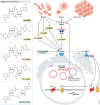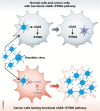Role of the cGAS-STING pathway in cancer development and oncotherapeutic approaches
- PMID: 30446584
- PMCID: PMC6280650
- DOI: 10.15252/embr.201846935
Role of the cGAS-STING pathway in cancer development and oncotherapeutic approaches
Abstract
The cyclic GMP-AMP synthase (cGAS)-stimulator of interferon genes (STING) pathway mediates anti-microbial innate immunity by inducing the production of type I interferons (IFNs) and inflammatory cytokines upon recognition of microbial DNA. Recent studies reveal that self-DNA from tumors and by-products of genomic instability also activates the cGAS-STING pathway and either promotes or inhibits tumor development. This has led to the development of cancer therapeutics using STING agonists alone and in combination with conventional cancer treatment or immune checkpoint targeting. On the other hand, for cancers lacking the cGAS-STING pathway and thus a regular innate immunity response, oncolytic virus therapy has been shown to have therapeutic potential. We here review and discuss the dichotomous roles of the cGAS-STING pathway in cancer development and therapeutic approaches.
Keywords: STING; cGAS; cancer; immune therapy; oncolytic virus.
© 2018 The Authors.
Figures



References
-
- Akira S, Uematsu S, Takeuchi O (2006) Pathogen recognition and innate immunity. Cell 124: 783–801 - PubMed
-
- Takeuchi O, Akira S (2010) Pattern recognition receptors and inflammation. Cell 140: 805–820 - PubMed
-
- Barber GN (2014) STING‐dependent cytosolic DNA sensing pathways. Trends Immunol 35: 88–93 - PubMed
-
- Chen Q, Sun L, Chen ZJ (2016) Regulation and function of the cGAS–STING pathway of cytosolic DNA sensing. Nat Immunol 17: 1142–1149 - PubMed
Publication types
MeSH terms
Substances
LinkOut - more resources
Full Text Sources
Other Literature Sources
Molecular Biology Databases
Research Materials

